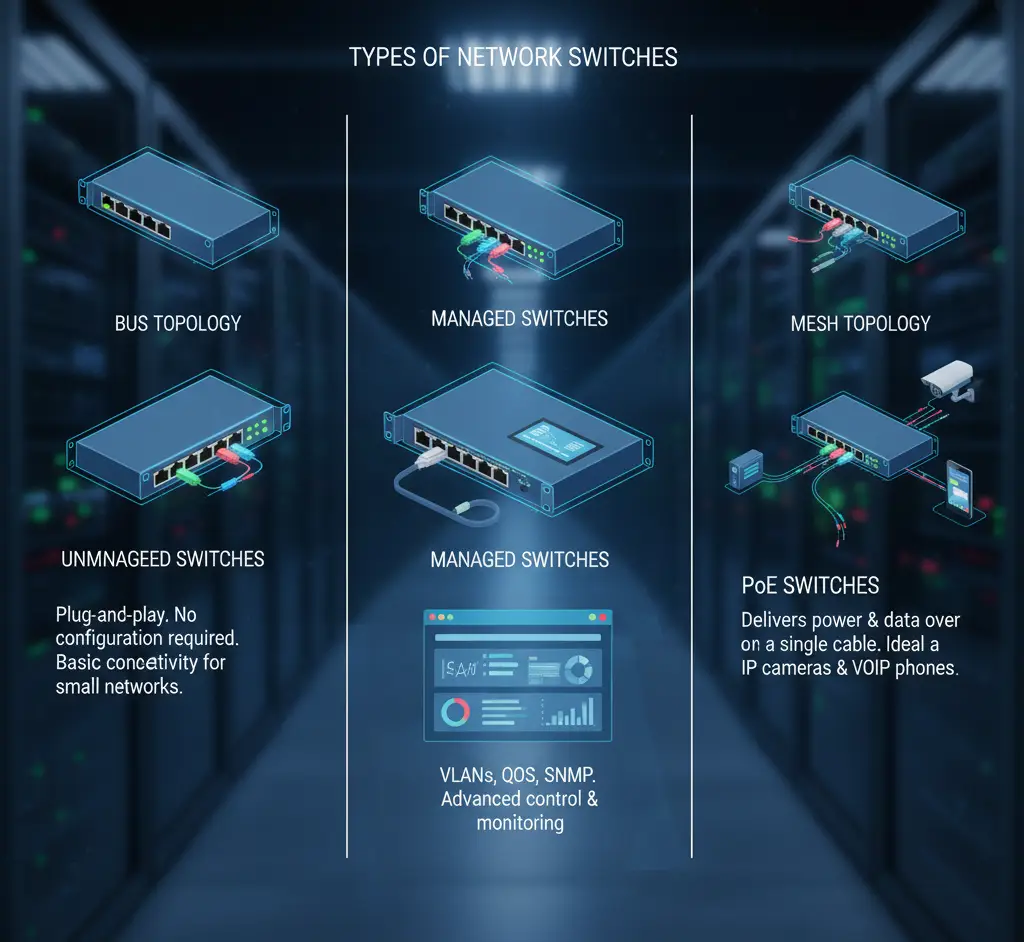
Introduction
The digital era means that the efficiency and security of computers are much more vital than they have ever been. The heart of every modern network is a fundamental method called the switching. It determines the way that data moves between servers, devices, and networks. This affects everything from downloading speeds to video quality. Being a networking engineer who has more than a decade of expertise having observed firsthand the way changing decisions made by switching could determine the success or failure of a system. This article explains the different types of switching actual use cases, deployment scenarios and practical suggestions for those looking to create or enhance the performance of a network.
What is Switching in Computer Networks?
Switching is the process employed to transport data packets between a source into the network. It’s an essential part of both wide and local networks. Instead of flood every device with data like hubs do switches study the information about their destination and smartly relay data towards the person who is intended to receive it.
Imagine a post office which is aware of where every letter will go, but determines the fastest way to go and keeps out congestion. It’s what switching does in networks. It ensures that data is taken the fastest route possible. It is the ultimate goal to increase efficiency, decrease delays, and guarantee an uninterrupted communications among devices.
Types of Switching Techniques
Switching is implemented using a variety of different ways. Each method has its own advantages, disadvantages and best use-cases dependent on the setting and the type of network traffic.
1. Circuit Switching
Circuit switching is a method of creating a connection between two devices prior to the data transfer begins. After the circuit has been created the circuit remains in operation until communication ceases.
Advantages:
-
Always guaranteed bandwidth for the duration of the entire session
-
A consistent performance, with very little variations in latency
Disadvantages:
-
Unefficient use of resources – a dedicated path when the system is idle
-
Setup time adds delay
-
Scalability is not optimal for networks with large numbers
Real-world example:
In the early days of voice communications like landline phones and circuit switching, it was the norm. I’ve helped design the call routing system of old which used a single call for the entire physical line. Moving away from circuit switching significantly increased efficiency while reducing the operational cost.
2. Message Switching
The message switching process does not create an unassailable path. Instead, all messages are transmitted and stored temporarily on each device in the intermediate stage until forwarding can be made.
Advantages:
-
Flexible and able to adapt to the load of the network
-
Effective in situations with different volume of traffic
Disadvantages:
-
Latency is high due to the complete message storage
-
This requires significant memory for the intermediate devices.
Application Cases:
Message switching is a good option for systems in which real-time speed is not required but integrity of the message is essential. I used the use of a secure messaging system among the data centers. In this case, delays were acceptable, but consistent delivery was preferable over speed.
3. Packet Switching
The most popular switch technique currently is called the use of packet switching. Data is split into smaller chunks called packets. They are sent out in a separate manner over the network.
Subtypes:
-
Switching of datagrams (connectionless): Packets traverse different routes before being and are reassembled when they reach the destination.
-
Virtual circuit switching (connection-oriented): A predefined path is used for all packets in a session
Advantages:
-
Efficient bandwidth usage
-
Resilient to link or node Failure
-
Multiple concurrent connections are supported.
Disadvantages:
-
Variable latency
-
The more intricate routing and assembly
Real-world scenario:
On the campus network of a university, I made the switch away from the old switching techniques using packet switching, which improved speed of file transfers by 40%, and also reduced traffic congestion in the network by a significant amount.
Switching Methods: Store-and-Forward vs Cut-Through
Beyond the switching type and methods of forwarding, the way in which they are handled is also important. What the switch does with every packet will affect delay, integrity of data as well as overall performance of the network.
Store-and-Forward Switching
This method is where a switch is able to receive the whole data packet, examines for any errors then transmits the data.
Pros:
-
This ensures that only valid messages are sent to the recipient.
-
Ideal for networks with the highest level of accuracy of their data.
Cons:
-
A little bit higher than the latency
Cut-Through Switching
The switch begins moving a packet in the moment when the destination address has been received, and does not wait for the complete packet to arrive.
Pros:
-
Lower latency
-
Useful in performance-sensitive environments
Cons:
-
Incorrect information in the packet can remain undetected
Hybrid Method:
Some advanced switches employ a mixture of both and adapting on the error rate or kind. In my experience deploying switches in a trading firm, enabling cut-through reduced latency by milliseconds–critical for real-time financial systems.
Types of Network Switches

The switches differ not only by their software features, but also in terms of hardware capabilities and uses. Below is the breakdown of:
Unmanaged Switches
-
Plug-and-play, no configuration
-
Ideal for smaller offices or homes with networks.
-
Control or visibility is limited.
Managed Switches
-
Support VLANs and QoS features, security and SNMP
-
In data centers.
-
Set up performance tuning and the management of faults
Layer 2 Switches
-
Operate by using MAC addresses
-
Manage traffic in the subnet
Layer 3 Switches
-
Use IP addresses to perform routing tasks. addresses
-
Enable communication between different subnets (inter-VLAN routing)
Power over Ethernet (Power over Ethernet) Switches
-
Transmit power and data via Ethernet cables.
-
It is useful to connect camera IPs, VoIP phones as well as wireless access points
Demonstrations of Deployment:
I previously implemented PoE switches over several floors in an hospital. Possibility of powering devices remotely greatly simplified the installation and also reduced the cost of cabling.
Network Design and Switching Topologies

A properly designed switching structure is essential for stability and the ability to scale.
Star Topology
-
Every device is connected to an centralized switch
-
It is easy to control and isolate the source of failures
Hierarchical Design
-
The layers are divided into access, distribution and central layers
-
The software is well-suited to large networks.
-
It allows redundancy and load balancing
Spine-Leaf Architecture
-
Common in data centers
-
Each leaf switch is connected to each spine switch
-
It ensures uniform latency and high bandwidth
Real-time deployment:
For the case of a software firm with increasing demands for cloud computing, we utilized an underlying spine-leaf topology. This enabled us to keep the highest throughput when increasing the number of servers, without having to redesign the whole network.
Case Study: Revamping a School Network
Problem:
A private school was struggling with poor internet speed and frequent disconnected. The network was created using disconnected switches as well as daisy-chained hubs.
Steps Taken:
-
Replaced all switches that are not managed by managed gigabit switches
-
Implemented VLANs that separate traffic from students, staff and administration traffic
-
Facilitated Quality of Service (QoS) to video conference
-
Created two uplinks to redundancy for redundant connections.
-
Centralized monitoring via SNMP tools
Results:
-
Internet performance and reliability have improved significantly
-
The staff could conduct online classes with no interruptions
-
The cost of maintenance is reduced thanks to improved quality fault isolation
Best Practices for Switching in Network Design
Here are some tips to make the most of the design for your network switch:
-
Always choose managed switches for the academic or professional setting
-
Make use of VLANs for segmenting traffic to improve security
-
Use link aggregation to increase capacity and greater redundancy
-
Do not use long daisy chained switches; Use hierarchical or star topologies
-
Continuously check switch logs as well as the port stats
-
Make sure to update firmware in a safe manner and make sure to test prior to deploying all over the world
-
Record switch configurations as well as physical layouts in case of troubleshooting
Conclusion
The switch is the mainstay of the modern network. From tiny office configurations to huge data centers, the method you use to implement switching determines the efficacy as well as the performance and capacity of your entire network. If you decide to go with either message or circuit packet switching, knowing these distinctions will help to make better design decisions. When you choose the appropriate switching methods, forwarding techniques and topologies as well as by taking lessons from actual world situations, you will be able to make sure that your network operates well and can support the users you want to support. Make sure that your network is in control of its future with the knowledge of switching.
Read More: The Ultimate Guide to Network Discovery Tools for IT Professionals

Leave a Reply